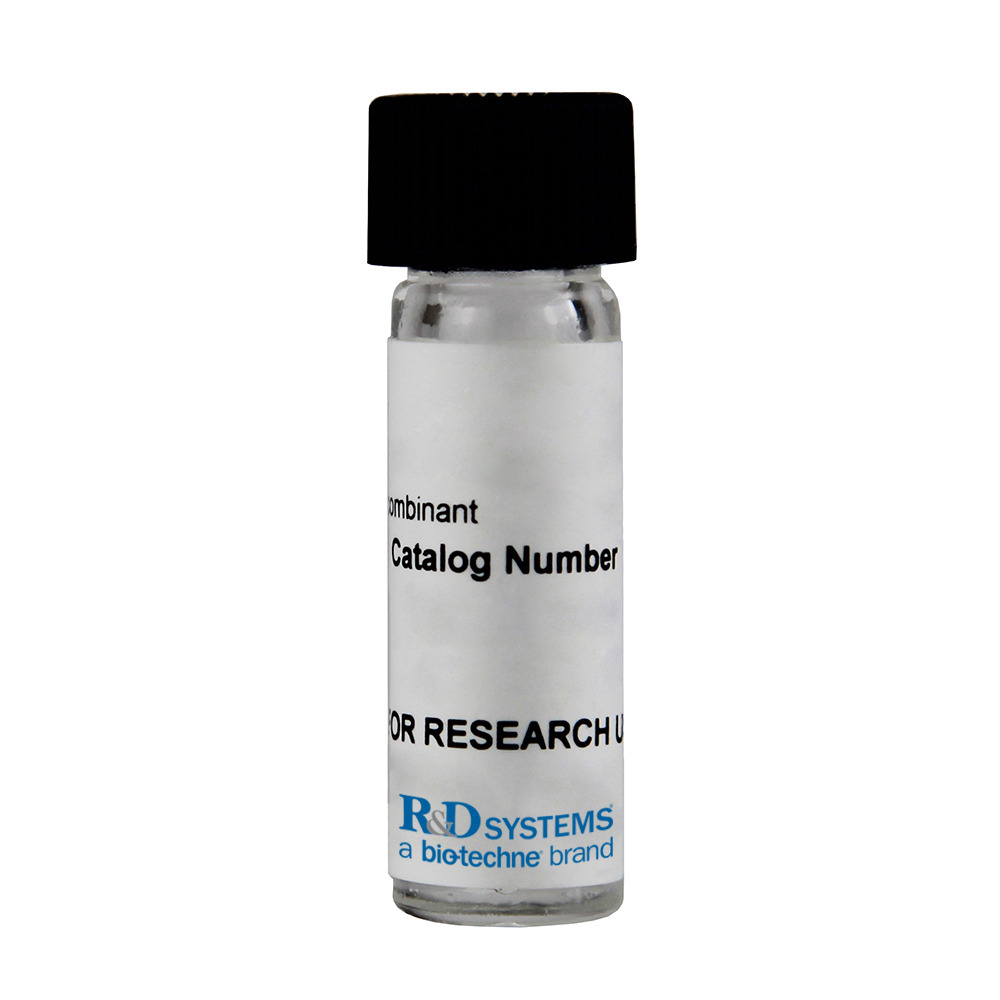Recombinant Human GFR alpha-3 Fc Chimera (CHO-expressed), CF
R&D Systems, part of Bio-Techne | Catalog # 7269-FR

Key Product Details
- R&D Systems CHO-derived Recombinant Human GFR alpha-3 Fc Chimera (CHO-expressed) (7269-FR)
- Quality control testing to verify active proteins with lot specific assays by in-house scientists
- All R&D Systems proteins are covered with a 100% guarantee
Source
Accession #
Structure / Form
Conjugate
Applications
Product Specifications
Source
| Human GFR alpha-3 (Asp32 - Asn374) Accession # O60609 |
IEGRD | Human IgG1 (Pro100 - Lys330) |
| N-terminus | C-terminus |
Purity
Endotoxin Level
N-terminal Sequence Analysis
Predicted Molecular Mass
SDS-PAGE
Activity
Immobilized Recombinant Human Artemin (Catalog # 2589-AR) at 1 µg/mL can bind Recombinant Human GFR alpha‑3/GDNF R alpha‑3 Fc Chimera with an apparent KD < 2 nM.
Formulation, Preparation and Storage
7269-FR
| Formulation | Lyophilized from a 0.2 μm filtered solution in PBS. |
| Reconstitution |
Reconstitute at 400 μg/mL in PBS.
|
| Shipping | The product is shipped at ambient temperature. Upon receipt, store it immediately at the temperature recommended below. |
| Stability & Storage | Use a manual defrost freezer and avoid repeated freeze-thaw cycles.
|
Background: GFR alpha-3/GDNF R alpha-3
Human glial cell line‑derived neurotrophic factor (GDNF) family receptor alpha 3 (GFR alpha‑3, GDNF R‑ alpha3) is an approximately 50 kDa plasma membrane glycoprotein that is one of four GDNF receptors, all of which are glycosylphosphoinositol (GPI)‑anchored, contain three conserved cysteine repeats, and promote survival of neurons (1 ‑ 4). It is synthesized as a 400 aa precursor with a 31 aa N‑terminal signal sequence, a 343 aa mature segment, and a C‑terminal GPI attachment signal sequence (3 ‑ 5). Human GFR alpha‑3 shares 81 ‑ 84% aa sequence identity with mouse, rat, equine, bovine and canine GFR alpha‑3. GFR alpha‑3 is expressed in the central nervous system only during the earliest stages of neurogenesis, while later it is predominantly found in developing and adult nociceptive sensory neurons (2, 4 ‑ 8). It is expressed with the shared GDNF coreceptor, the Ret receptor tyrosine kinase, in the trigeminal ganglion, pituitary gland, thymus, lung, and duodenum (2, 4). Its ligand, the GDNF family ligand artemin, is primarily expressed by immature Schwann cells in the peripheral nervous system, and vascular smooth muscle cells, directing axonal projection of sympathetic neurons (6, 7). Artemin first binds GFR alpha‑3, which recruits Ret, forming a signaling complex that is a pentamer containing one artemin, two GFR‑ alpha3, and two Ret molecules (1, 6, 9). Signals from this complex are required for the development and survival of the superior cervical ganglion (SCG) neurons, and deletion of mouse GFR alpha‑3 results in deficits in the SCG and inhibited development of intestinal Peyer’s patches (6, 7, 10, 11).
References
- Wang, X. et al. (2006) Structure 14:1083.
- Naveilhan, P. et al. (1998) Proc. Natl. Acad. Sci. USA 95:1295.
- Nomoto, S. et al. (1998) Biochem. Biophys. Res. Commun. 244:849.
- Baloh, R. et al. (1998) Proc. Natl. Acad. Sci. USA 95:5801.
- Worby, C. et al. (1998) J. Biol. Chem. 273:3502.
- Baloh, R. et al. (1998) Neuron 21:1291.
- Honma, Y. et al. (2002) Neuron 35:267.
- Orozco, O.E. et al.(2001) Eur. J. Neurosci. 13:2177.
- Schlee, S. et al. (2006) Nat. Chem. Biol. 2:636.
- Nishino, J et al. (1999) Neuron 23:725.
- Veiga-Fernandez, H. et al. (2007) Nature 446:547.
Long Name
Alternate Names
Gene Symbol
UniProt
Additional GFR alpha-3/GDNF R alpha-3 Products
Product Documents for Recombinant Human GFR alpha-3 Fc Chimera (CHO-expressed), CF
Product Specific Notices for Recombinant Human GFR alpha-3 Fc Chimera (CHO-expressed), CF
For research use only
